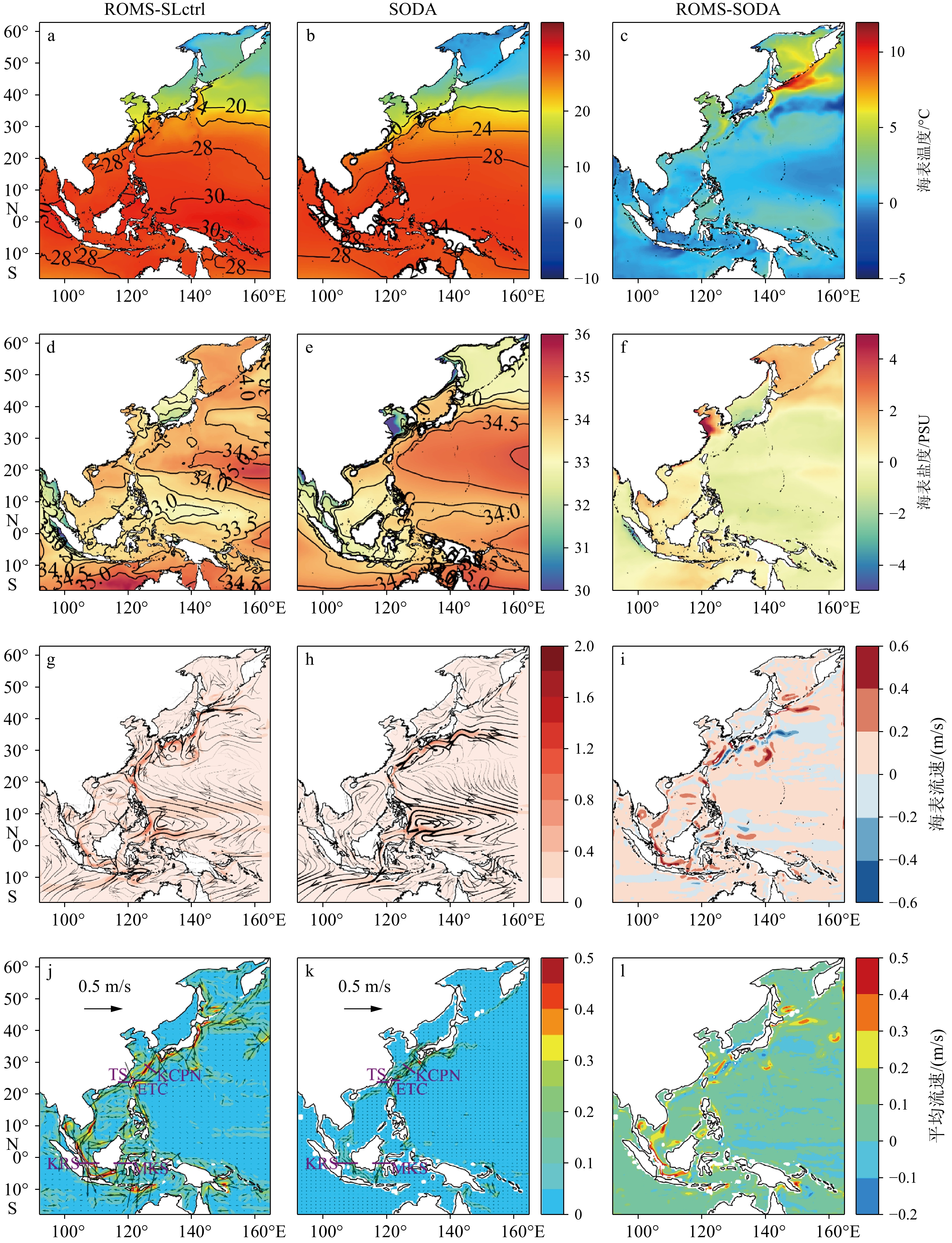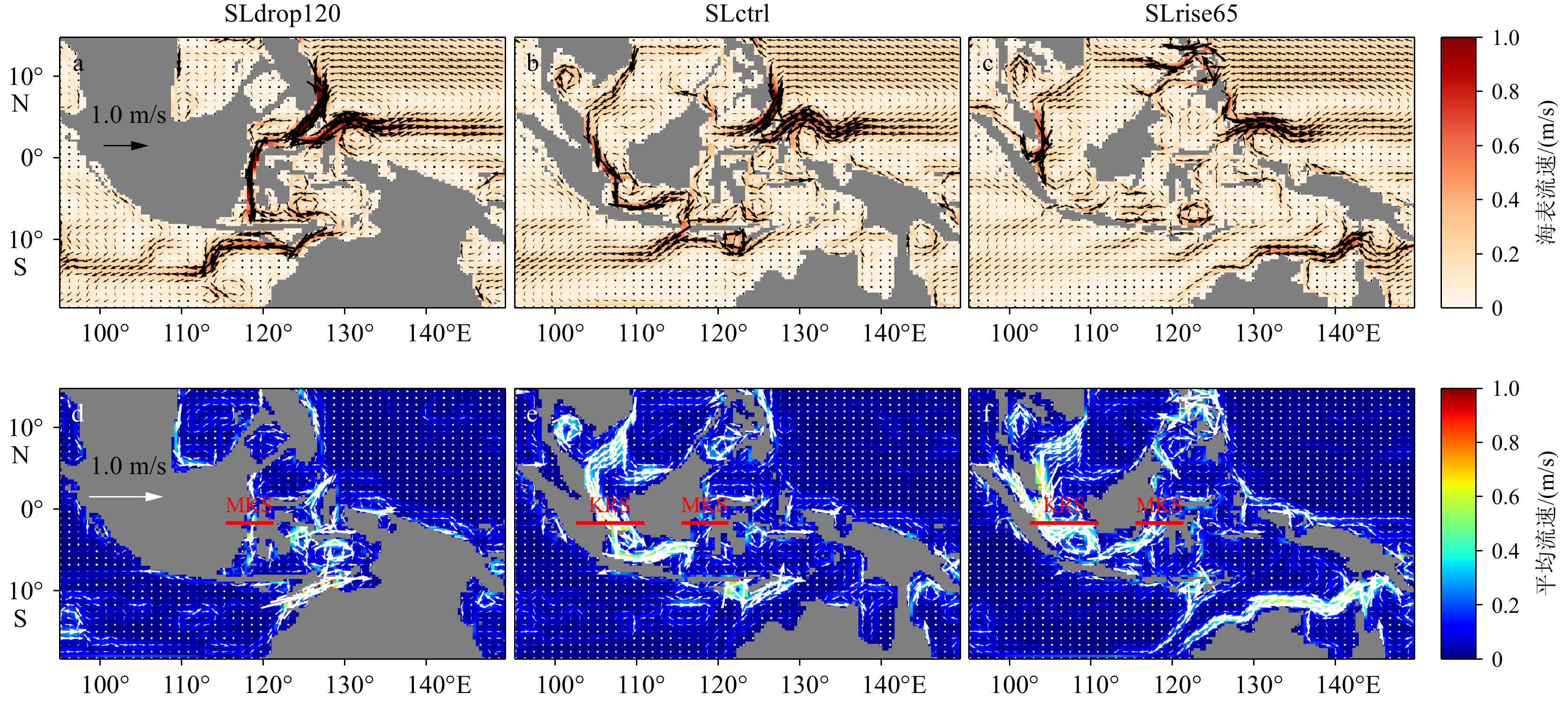The response of the Western Pacific to high-and low-sea levels: based on ROMS experiments
-
摘要:
地质历史时期海平面变化叠加在板块运动之上,引起海岸线进退、沿海和陆架区域出露或淹没,从而影响全球大洋环流格局和区域海洋系统。本研究聚焦西太平洋对极端海平面升降的响应,使用区域海洋模式(ROMS)探讨末次盛冰期(LGM)情景下极端低海平面SLdrop120(海平面下降120 m)和全球大陆冰盖融化情况下极端高海平面SLrise65(海平面上升65 m)对该区域温盐格局和主要洋流的影响。研究结果显示,海平面升降对该区域洋流系统有重要非线性影响,而对温盐格局影响主要体现在边缘海或靠近大陆边缘区域,且可以通过贯通性变化来解释这些差异。与现代海平面相比,极端低海平面导致近岸陆架海出露、台湾海峡关闭等,切断了西边界流入侵南海,导致东海的黑潮输运向外海方向移动,主轴断面流量减少。与前人考虑LGM冰期气候态的研究结果相比,此减少趋势说明LGM时期海平面降低和冰期气候驱动的效应相抵消。而高海平面则引起岸线向陆推移,渤海等近海海域面积增加、台湾海峡拓宽,使得西边界流向西拓展,对黑潮主流结构有分流作用。关于控制太平洋和印度洋交换的印尼贯穿流ITF,其西支路径因水深较浅而对海平面变化响应更明显。在极端低海平面情景下,卡里马塔海峡关闭、ITF的西支被切断,来自西支的淡水阻塞效应因此消失,这导致通过望加锡海峡的流量反而增加了2.31 Sv(1Sv=1×106 m3/s);相反,在高海平面情景下,西侧的卡里马塔海峡和望加锡海峡均变宽,同时托雷斯海峡打开,使得进入印度洋的流量比现在海平面情景增大。这些结果表明,西太平洋黑潮和印尼贯穿流对海岸线变迁的响应呈非线性规律,并强调了地质历史演化过程中海平面变化对区域洋流的重要作用。
-
关键词:
- 区域海洋模式(ROMS) /
- 东海黑潮 (KC) /
- 印尼贯穿流 (ITF) /
- 大陆冰量变化 /
- 极端海平面升降
Abstract:Superimposed on tectonic movements, sea level changes during geologic history caused coastline advancement and retreat, exposing shallow shelf or submerging coastal regions, and thus influencing regional ocean currents and global ocean circulation. The Regional Ocean Model (ROMS) was used to simulate the response of the West Pacific thermohaline pattern and major ocean currents in the low sea level scenarios, e.g., the SLdrop120 (sea level drop by 120 m) case during the last glacial maximum (LGM), and the high sea level scenarios, e.g., the SLrise65 (sea level rise by 65 m) case during the global ice sheet melting. Results show that sea level rise and fall have more significant non-linear influences on ocean currents than on temperature and salinity schemes. Compared with the modern sea level, the extremely low sea level led to the exposure of the near-shore shelf sea and the closure of the Taiwan Strait, cutting off the invasion of the western boundary current into the South China Sea, causing the Kuroshio transport in the East China Sea to move toward the open sea and reducing the flow rate in the main axis section. Compared with previous research results considering the LGM glacial climate state, this decreasing trend indicates that the effects of sea level drop during the LGM period and glacial climate driving offset each other. The high sea level pushes the shoreline landward, the area of coastal waters such as the Bohai Sea increases, and the Taiwan Strait widens, causing the western boundary current to expand westward, which would diverse the mainstream of the Kuroshio. Regarding the Indonesian Throughflow (ITF), which controls the exchange between the Pacific and Indian Oceans, its western branch path responds more significantly to sea level changes due to its shallower depth. Under the extreme low sea level scenario, the Karimata Strait is closed and the western branch of the ITF is cut off, so the freshwater blocking effect from the western branch disappears, which leads to an increase of 2.31 Sv (1 Sv=1×106 m3/s) in the flow through the Makassar Strait. On the contrary, under the high sea level scenario, both the Karimata Strait and the Makassar Strait on the west side are widened, and the Torres Strait is opened, which makes the flow into the Indian Ocean larger than the modern sea level scenario. This study demonstrated that the responses of the Kuroshio and the Indonesian Throughflow in the western Pacific to the change of the coastline is nonlinear, and emphasized the important role of sea level changes in regional ocean currents during geological evolution.
-

-
表 1 黑潮和印尼贯穿流的关键断面年平均流量 (Sv)
Table 1. The annual mean volume transport cross sections (in Sv) relevant to Kuroshio and ITF
试验 黑潮 印尼贯穿流 KCPN TS ETC KRS MKS SODA 16.32 1.22 21.59 −1.17 −11.02 HYCOM 11.45 1.29 23.74 −0.54 −11.39 SLctrl 20.00 0.79 28.17 −3.88 −3.0 SLrise65 11.70 3.68 22.00 −4.21 −1.32 SLdrop120 9.82 0 14.80 0 −5.31 注:KCPN: 黑潮主轴断面, TS: 台湾海峡, ETC:台湾岛东侧海峡, KRS:卡里马塔海峡, MKS: 望加锡海峡。 表中断面流量是通过断面平均流速(图5d-f、 6d-f)乘以断面面积所得,负号表示方向向南或者向西。 -
[1] Garwood Jr R W. Air-sea interaction and dynamics of the surface mixed layer[J]. Reviews of Geophysics, 1979, 17(7):1507-1524. doi: 10.1029/RG017i007p01507
[2] Wang J, Yuan D L, Zhao X. Impacts of Indonesian Throughflow on seasonal circulation in the equatorial Indian Ocean[J]. Chinese Journal of Oceanology and Limnology, 2017, 35(6):1261-1274. doi: 10.1007/s00343-017-6196-0
[3] Yuan D L, Yin X L, Li X, et al. A Maluku Sea intermediate western boundary current connecting Pacific Ocean circulation to the Indonesian Throughflow[J]. Nature Communications, 2022, 13(1):2093. doi: 10.1038/s41467-022-29617-6
[4] Hogg N G, Johns W E. Western boundary currents[J]. Reviews of Geophysics, 1995, 33(S2):1311-1334. doi: 10.1029/95RG00491
[5] 张灿影, 冯志纲, 张晓琨, 等. 黑潮研究进展分析[J]. 世界科技研究与发展, 2017, 39(3):239-249
ZHANG Canying, FENG Zhigang, ZHANG Xiaokun, et al. Analysis on research progress of kuroshio[J]. World Sci-Tech R& D, 2017, 39(3):239-249.]
[6] Hu D X, Wu L X, Cai W J, et al. Pacific western boundary currents and their roles in climate[J]. Nature, 2015, 522(7556):299-308.
[7] Gordon A L. Interocean exchange of thermocline water[J]. Journal of Geophysical Research: Oceans, 1986, 91(C4):5037-5046. doi: 10.1029/JC091iC04p05037
[8] Qu T D, Kim Y Y, Yaremchuk M, et al. Can Luzon strait transport play a role in conveying the impact of ENSO to the South China Sea?[J]. Journal of Climate, 2004, 17(18):3644-3657. doi: 10.1175/1520-0442(2004)017<3644:CLSTPA>2.0.CO;2
[9] Fang G H, Susanto D, Soesilo I, et al. A note on the South China Sea shallow interocean circulation[J]. Advances in Atmospheric Sciences, 2005, 22(6):946-954.
[10] Wajsowicz R C. A relationship between interannual variations in the south pacific wind stress curl, the Indonesian throughflow, and the west pacific warm water pool[J]. Journal of Physical Oceanography, 1994, 24(10):2180-2187. doi: 10.1175/1520-0485(1994)024<2180:ARBIVI>2.0.CO;2
[11] Du Y, Qu T D. Three inflow pathways of the Indonesian throughflow as seen from the simple ocean data assimilation[J]. Dynamics of Atmospheres and Oceans, 2010, 50(2):233-256. doi: 10.1016/j.dynatmoce.2010.04.001
[12] Fang G H, Wei Z X, Choi B H, et al. Interbasin freshwater, heat and salt transport through the boundaries of the East and South China Seas from a variable-grid global ocean circulation model[J]. Science in China Series D: Earth Sciences, 2003, 46(2):149-161. doi: 10.1360/03yd9014
[13] 张晶, 魏泽勋, 李淑江, 等. 太平洋—印度洋贯穿流南海分支研究综述[J]. 海洋科学进展, 2014, 32(1):107-120 doi: 10.3969/j.issn.1671-6647.2014.01.013
ZHANG Jing, WEI Zexun, LI Shujiang, et al. Overviews on studies of the South China Sea branch of the Pacific-Indian Ocean throughflow[J]. Advances in Marine Science, 2014, 32(1):107-120.] doi: 10.3969/j.issn.1671-6647.2014.01.013
[14] Qu T D, Du Y, Sasaki H. South China Sea throughflow: a heat and freshwater conveyor[J]. Geophysical Research Letters, 2006, 33(23):L23617.
[15] Gordon A L, Huber B A, Metzger E J, et al. South China Sea throughflow impact on the Indonesian throughflow[J]. Geophysical Research Letters, 2012, 39(11):L11602.
[16] Sprintall J, Gordon A L, Koch-Larrouy A, et al. The Indonesian seas and their role in the coupled ocean–climate system[J]. Nature Geoscience, 2014, 7(7):487-492. doi: 10.1038/ngeo2188
[17] Straume E O, Gaina C, Medvedev S, et al. Global Cenozoic Paleobathymetry with a focus on the Northern Hemisphere Oceanic Gateways[J]. Gondwana Research, 2020, 86:126-143. doi: 10.1016/j.gr.2020.05.011
[18] 王绍武. 冰期-间冰期旋回[J]. 气候变化研究进展, 2008, 4(1):61-62
WANG Shaowu. Glacial-interglacial cycles[J]. Climate Change Research, 2008, 4(1):61-62.]
[19] 王凡, 胡敦欣, 穆穆, 等. 热带太平洋海洋环流与暖池的结构特征、变异机理和气候效应[J]. 地球科学进展, 2012, 27(6):595-602
WANG Fan, HU Dunxin, MU Mu, et al. Structure, variations and climatic impacts of ocean circulation and the warm pool in the tropical Pacific Ocean[J]. Advances in Earth Science, 2012, 27(6):595-602.]
[20] Tang Z J, Zhang R H, Wang H N, et al. Mesoscale surface Wind-SST coupling in a high-resolution CESM over the KE and ARC regions[J]. Journal of Advances in Modeling Earth Systems, 2021, 13(12):e2021MS002822. doi: 10.1029/2021MS002822
[21] 赵宗慈, 罗勇, 黄建斌. 全球变暖和海平面上升[J]. 气候变化研究进展, 2019, 15(6):700-703
ZHAO Zongci, LUO Yong, HUANG Jianbin. Global warming and sea level rising[J]. Climate Change Research, 2019, 15(6):700-703.]
[22] 赵子荟, 马文涛, 张晓. 末次冰盛期黑潮变化的数值模拟[J]. 第四纪研究, 2023, 43(4):1029-1041 doi: 10.11928/j.issn.1001-7410.2023.04.11
ZHAO Zihui, MA Wentao, ZHANG Xiao. Numerical simulation of the kuroshio current during the last glacial maximum[J]. Quaternary Sciences, 2023, 43(4):1029-1041.] doi: 10.11928/j.issn.1001-7410.2023.04.11
[23] Shchepetkin A F, McWilliams J C. The regional oceanic modeling system (ROMS): a split-explicit, free-surface, topography-following-coordinate oceanic model[J]. Ocean Modelling, 2005, 9(4):347-404. doi: 10.1016/j.ocemod.2004.08.002
[24] 周立佳, 党振中, 董慧超, 等. 基于ROMS模式的东海黑潮季节变化特征模拟研究[J]. 舰船电子工程, 2016, 36(7):91-94,153 doi: 10.3969/j.issn.1672-9730.2016.07.023
ZHOU Lijia, DANG Zhenzhong, DONG Huichao, et al. Seasonal variation characteristics of the Kuroshio in the East China Sea based on ROMS[J]. Ship Electronic Engineering, 2016, 36(7):91-94,153.] doi: 10.3969/j.issn.1672-9730.2016.07.023
[25] 陈毓敏, 项杰, 杜华栋, 等. 基于拉格朗日方法对黑潮路径的数值模拟[J]. 海洋预报, 2019, 36(6):22-28 doi: 10.11737/j.issn.1003-0239.2019.06.003
CHEN Yumin, XIANG Jie, DU Huadong, et al. Numerical simulation of Kuroshio path based on Lagrangian method[J]. Marine Forecasts, 2019, 36(6):22-28.] doi: 10.11737/j.issn.1003-0239.2019.06.003
[26] Fretwell P, Pritchard H D, Vaughan D G, et al. Bedmap2: improved ice bed, surface and thickness datasets for Antarctica[J]. The Cryosphere, 2013, 7(1):375-393. doi: 10.5194/tc-7-375-2013
[27] Clark P U, Mix A C. Ice sheets and sea level of the Last Glacial Maximum[J]. Quaternary Science Reviews, 2002, 21(1-3):1-7. doi: 10.1016/S0277-3791(01)00118-4
[28] Shapiro R. Linear filtering[J]. Mathematics of Computation, 1975, 29(132):1094-1097. doi: 10.1090/S0025-5718-1975-0389356-X
[29] Hsin Y C, Wu C R, Shaw P T. Spatial and temporal variations of the Kuroshio east of Taiwan, 1982–2005: a numerical study[J]. Journal of Geophysical Research: Oceans, 2008, 113(C4):C04002.
[30] Wei Y Z, Huang D J, Zhu X H. Interannual to decadal variability of the Kuroshio Current in the East China Sea from 1955 to 2010 as indicated by in-situ hydrographic data[J]. Journal of Oceanography, 2013, 69(5):571-589. doi: 10.1007/s10872-013-0193-5
[31] Yuan Y C, Kaneko A, Su J L, et al. The Kuroshio East of Taiwan and in the East China Sea and the currents East of Ryukyu Islands during early summer of 1996[J]. Journal of Oceanography, 1998, 54(3):217-226. doi: 10.1007/BF02751697
[32] Gordon A L, Napitu A, Huber B A, et al. Makassar strait throughflow seasonal and interannual variability: an overview[J]. Journal of Geophysical Research: Oceans, 2019, 124(6):3724-3736. doi: 10.1029/2018JC014502
[33] Susanto R D, Ffield A, Gordon A L, et al. Variability of Indonesian throughflow within Makassar Strait, 2004–2009[J]. Journal of Geophysical Research: Oceans, 2012, 117(C9):C09013.
[34] Gordon A L, Sprintall J, Van Aken H M, et al. The Indonesian throughflow during 2004–2006 as observed by the INSTANT program[J]. Dynamics of Atmospheres and Oceans, 2010, 50(2):115-128. doi: 10.1016/j.dynatmoce.2009.12.002
[35] Liang L L, Xue H J, Shu Y Q. The Indonesian throughflow and the circulation in the Banda Sea: a modeling study[J]. Journal of Geophysical Research: Oceans, 2019, 124(5):3089-3106. doi: 10.1029/2018JC014926
[36] Sprintall J, Wijffels S E, Molcard R, et al. Direct estimates of the Indonesian Throughflow entering the Indian Ocean: 2004–2006[J]. Journal of Geophysical Research: Oceans, 2009, 114(C7):C07001.
[37] Wang J, Zhang Z B, Li X, et al. Moored observations of the Timor passage currents in the Indonesian Seas[J]. Journal of Geophysical Research: Oceans, 2022, 127(11):e2022JC018694. doi: 10.1029/2022JC018694
[38] Nan F, Xue H J, Yu F. Kuroshio intrusion into the South China Sea: a review[J]. Progress in Oceanography, 2015, 137:314-333. doi: 10.1016/j.pocean.2014.05.012
[39] Tozuka T, Qu T D, Yamagata T. Dramatic impact of the South China Sea on the Indonesian Throughflow[J]. Geophysical Research Letters, 2007, 34(12):L12612.
[40] Tozuka T, Qu T D, Masumoto Y, et al. Impacts of the South China Sea Throughflow on seasonal and interannual variations of the Indonesian Throughflow[J]. Dynamics of Atmospheres and Oceans, 2009, 47(1-3):73-85. doi: 10.1016/j.dynatmoce.2008.09.001
[41] Wu C R, Wang Y L, Lin Y F, et al. Intrusion of the Kuroshio into the South and East China Seas[J]. Scientific Reports, 2017, 7(1):7895. doi: 10.1038/s41598-017-08206-4
-




 下载:
下载:




